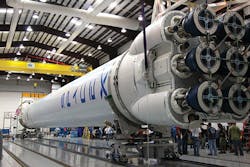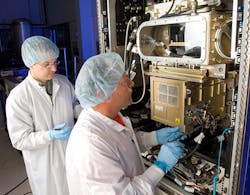The Commercialization of Space: Selling the Final Frontier
The family piles into the vehicle for vacation.
They strap in, ready for the 220-mile trip.
Up.
Straight up.
Secured in a commercial vessel, donning intra-vehicular activity space suits, they are thrust back against their seats as the capsule rockets into the air. Within minutes, they experience 2½ Gs, feeling more than double their own weight pressing upon them.
And, after just 8½ minutes, they enter space and are weightless.
It takes a few more hours for the capsule to rendezvous with the private space station -- an inflatable orbiting habitat they've rented for their holiday in space.
Private space flight is nothing new. A handful of individuals had already entered orbit before 2010 when the International Space Station's crew size was increased and there was no longer room for paying astronauts on the Soyuz spacecraft.
But it's still novel. And now it's becoming commercial.
| Commercial Space: Emerging From Catastrophe |
The commercialization of space isn't just about sending the elite on extraterrestrial excursions. It's about transitioning the space industry from one propped up by the government to something self-sufficient; it's about private enterprise investing in rockets, in equipment, in experiments in space.
It's about NASA stepping aside after 60 years of building a basic space infrastructure.
It's about the future. The future of space.
"It's still an inchoate industry. It's still embryonic and young," says Ted Southern, president of Final Frontier Design, a New York-based private design firm that makes aerospace safety garments.
But it's growing.
As the government switches to riskier and more difficult deep space missions, the speculation is that it will increasingly turn more established functions like lower Earth orbit -- where ISS orbits -- over to private enterprise.
Bigelow Aerospace is already under contract with NASA to send the Bigelow Expandable Activity Module to the International Space Station in mid-2015. The 13-by-10-foot inflatable module will attach to the ISS to test the viability of such structures in space for use as laboratories or hotels, as is the desire of founder and hotel executive Robert Bigelow.
And Virgin Galactic, which has a 700-person waiting list for its $250,000 suborbital spaceflights, has chartered flights of its spacecraft to NASA for research.
Even more notable, in September NASA awarded contracts to SpaceX and Boeing to transport crews to and from the ISS.
At the time of that announcement, NASA administrator Charlie Bolden said, "Turning over low-Earth orbit transportation to private industry will also allow NASA to focus on an even more ambitious mission: sending humans to Mars."
That means the government, rather than hiring companies, is now contracting services from commercial enterprise.
While a subtle change, it's indicative of a slow shift in how the industry will operate. It means NASA is gradually handing off responsibility for certain functions in space, and companies will increasingly assume the risks of space.
A Risky Endeavor
In seeing the changes coming in the industry, Virginia-based Alion Science and Technology Corp. several years ago made a decision to change how it did business in order to balance both government and commercial contracts.
Whereas government contracts are out two years in advance, a commercial contract could be for immediate delivery.
"We're ready to work a little quicker, a little more dynamically than you would on a government order," says Mike Kenny, senior chemist at Alion.
Kenny, who leads a team that makes protective coatings for spacecraft, was able to double the size of his small workforce and now keeps inventory on hand, making his team ready for the quick turnaround needed on orders from companies like SpaceX, for which Alion provided the thermal control coating for the trunk of the first Dragon capsule.
On a project with an established government contractor like Lockheed Martin, Alion has to meet a schedule but not a launch schedule. With SpaceX, Alion works toward a launch date.
"With SpaceX, that stuff's going up fast. It's a quick timeline," Kenny says. "There's not a lot of wiggle room."
It is that balance, that juggling of government contracts and commercial deals, that enables companies like Alion to take the risk associated with the commercial space industry.
Because relying solely on the commercial industry at this point isn't sustainable in the experience of Final Frontier's Southern.
Southern, whose company deals mostly with NASA, says the commercial market isn't established enough yet.
"There's participation from the commercial space industry, but the actual orders, the actual movement of the supply chain, hasn't really happened at this point because they're not flying. They're not thinking about space suits in particular," Southern says.
"We're here the same way a lot of these space startups are: We're betting on a future. We're spending a lot of money now for a product to be used in the future."
To mitigate that risk, Final Frontier is using its expertise in the extraterrestrial market to create technologies that can be used on Earth, Southern says. While working on intra- and extra-vehicular activity space suits, Final Frontier also is developing a new padding for firemen's gloves.
Navigating a New World
As the commercial market continues to mature, the trick is in figuring out how to navigate that new market, says Carlos Grodsinsky, chief operating officer and senior vice president of technology at ZIN Technologies, an Ohio-based engineering services firm. "From our vantage point, operationally it really isn't different. You still need the same type of resources and knowledge base," Grodsinsky says about the commercial market. The major difference, he says, is in marketing. "Now we're trying to figure out how to market, brand and basically sell our capabilities to this broader market that we all hope and expect to emerge," Grodsinsky says. "To tell you the absolute truth, everyone is trying to figure out what that market will become." For a company like ZIN, which has worked with NASA for 25 years, that means a noticeable change not in operations but in how the company conducts business. ZIN now can't rely solely on NASA or its traditional partners in this new market; it has to market to the space access companies directly and to new players in the game. "I think it's traditional marketing and sales," Grodsinsky says. "It's just a nuance of it. The difference is to figure out where that market is emerging. It's not established."About the Author
Ginger Christ
Ginger Christ, Associate Editor
Ginger Christ is a former associate editor for EHS Today, a Penton publication.
She has covered business news for the past seven years, working at daily and weekly newspapers and magazines in Ohio, including the Dayton Business Journal and Crain's Cleveland Business.
Most recently, she covered transportation and leadership for IndustryWeek, a sister publication to EHS Today.
She holds a bachelor of arts in English and in Film Studies from the University of Pittsburgh.



